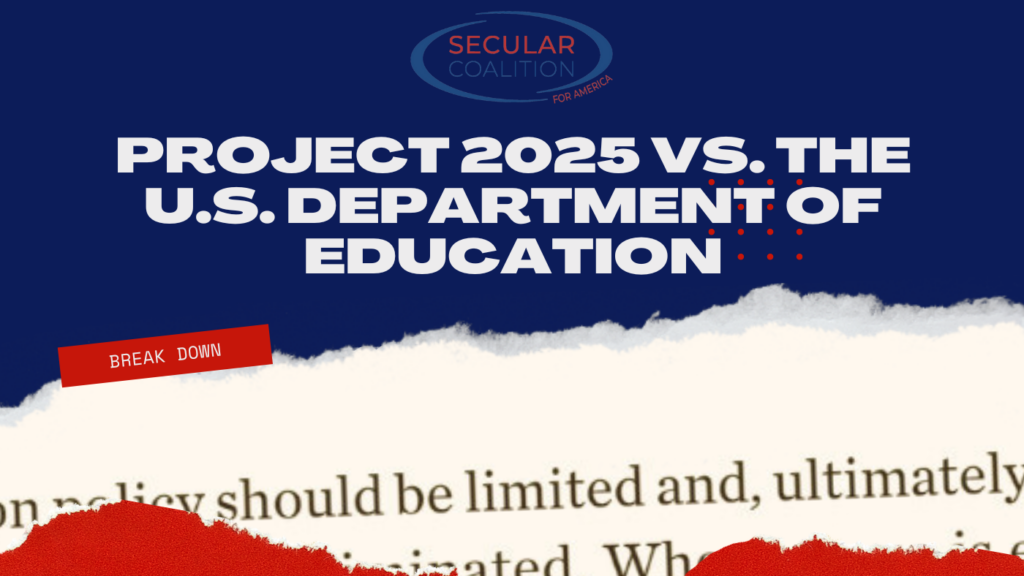The primary recommendation in Project 2025 for the Department of Education is to eliminate it. When President Carter signed the Department of Education Organization Act in 1979 the goal was to bring various federal education programs at different federal agencies under one roof to improve efficiency. Project 2025 would simply reverse that process. It says, “The next Administration will need a plan to redistribute the various congressionally approved federal education programs across the government, eliminate those that are ineffective or duplicative, and then eliminate the unproductive red tape and rules by entrusting states and districts with flexible, formula-driven block grants. This chapter details that plan.”
Two examples of the goal of breaking up the Department of Education: “Move student-driven Impact Aid programs {funding for school districts with large military bases} to the Department of Defense Education Authority or the Department of Interior’s Bureau of Indian Education.” Also, “Transfer all Indian education programs to the Bureau of Indian Education.”
The block grants are the key to the second goal, which is to use federal money as well as tax credits to help parents send their children to private and religious schools at the expense of and to the detriment of the public school systems. If you send essentially blank checks to the states, and the states have “school choice” voucher programs in place or initiate them, then the federal government is funding private and religious schools to a far greater extent than it already is today.
The third goal is to help religious schools avoid federal regulations that prevent them from discriminating based on religious beliefs or lack of them.
The stated core principles in Project 2025 are:
- “Advancing education freedom. Empowering families to choose among a diverse set of education options is key to reform and improved outcomes, and it can be achieved without establishing a new federal program. For example, portability of existing federal education spending to fund families directly or allowing federal tax credits to encourage voluntary contributions to K–12 education savings accounts managed by charitable nonprofits, could significantly advance education choice.”
Meaning: Take federal funding now going to public schools and redirect it to voucher programs and tuition tax credits including states that allow such funds to go to private and religious schools.
- “Providing education choice for “federal” children. Congress has a special responsibility to children who are connected to military families, who live in the District of Columbia, or who are members of sovereign tribes. Responsibility for serving these students should be housed in agencies that are already serving these families.”
So moving these programs out of the Department of Education as part of the plan to dismantle it.
- “Restoring state and local control over education funding. As Washington begins to downsize its intervention in education, existing funding should be sent to states as grants over which they have full control, enabling states to put federal funding toward any lawful education purpose under state law.”
Block grants to the states which then decide on spending priorities.
- “Treating taxpayers like investors in federal student aid. Taxpayers should expect their investments in higher education to generate economic productivity. When the federal government lends money to individuals for a postsecondary education, taxpayers should expect those borrowers to repay.”
No student loan forgiveness.
- “Protecting the federal student loan portfolio from predatory politicians. The new Administration must end the practice of acting like the federal student loan portfolio is a campaign fund to curry political support and votes. The new Administration must end abuses in the loan forgiveness programs. Borrowers should be expected to repay their loans.”
Again, No student loan forgiveness.
- “Safeguarding civil rights. Enforcement of civil rights should be based on a proper understanding of those laws, rejecting gender ideology and critical race theory.”
Crack down on the trans kids and stop teaching CRT, a college-level topic, to K-12 students who aren’t being taught it now.
- “Stopping executive overreach. Congress should set policy—not Presidents through pen-and-phone executive orders, and not agencies through regulations and guidance. National emergency declarations should expire absent express congressional authorization within 60 days after the date of the declaration.”
We’re going to stop doing what every president does; executive orders and regulatory guidance concerning federal education programs.
Let’s talk about the block grant proposal. The federal government spends about $100 billion each year on K-12 education, which is about ten percent of the total budget for these K-12 schools. The other 90 percent comes from state and local governments. Here’s what’s likely to happen if we just turn that over to state or local governments with little to no strings attached: Some will spend it appropriately and some will not. Some states now allow chaplains to replace school counselors, or require the Ten Commandments in every classroom, or have tried to start a Catholic charter school. Many other states will follow in those footsteps if the courts allow it. The Project 2025 language says “eliminate the unproductive red tape and rules by entrusting states and districts with flexible, formula-driven block grants.” Entrusting the states to keep funding public schools adequately seems like a big gamble with taxpayer money.
Block grants do not always work out the way Congress intends. Here is what happened when Congress replaced Aid to Families With Dependent Children, known as the welfare program, with TANF block grants in 1996, according to the Center on Budget and Policy Priorities: “Over time, states redirected a substantial portion of their state and federal TANF funds to other purposes, to fill state budget holes, and in some cases to substitute for existing state spending. Even when need increased during the Great Recession, states were often unable to bring the funds back to core welfare reform services and instead made cuts in basic assistance, child care, and work programs.”
Of course education funding enjoys a better reputation than funding for welfare ever did, and the money might not be misused as much, but Project 2025 would have us roll the dice on sending about $100 billion to the state governments and hoping for the best. There’s also this consideration: The annual federal TANF block grant has been frozen since its creation and lost about 47 percent of its value between 1997 and 2021 due to inflation. Once federal education money is just a block grant, it’s much easier to get the federal government out of spending so much on education.
Finally, there is a grab bag of policy proposals in the Education chapter that collectively allow religious schools and colleges to avoid or discriminate against trans kids, avoid implementing DEI programs, crack down on pronouns, and avoid nondiscrimination requirements at accrediting organizations. Here are some of those policies:
- Families and students should be free to choose from a diverse set of school options and learning environments that best fit their needs. Our postsecondary institutions should also reflect such diversity, with room for not only “traditional” liberal arts colleges and research universities but also faith-based institutions, career schools, military academies, and lifelong learning programs.
- Work with Congress to amend Title IX to include due process requirements; define “sex” under Title IX to mean only biological sex recognized at birth; and strengthen protections for faith-based educational institutions, programs, and activities.
- Of particular concern are efforts by many accreditation agencies to leverage their Title IV (student loans and grants) gatekeeper roles to force institutions to adopt policies that have nothing to do with academic quality assurance and student outcomes. One egregious example of this is the extent to which accreditors have forced colleges and universities, many of them faith-based institutions, to adopt diversity, equity, and inclusion policies that conflict with federal civil rights laws, state laws, and the institutional mission and culture of the schools.
- Protect faith-based institutions by prohibiting accreditation agencies from: Requiring standards and criteria that undermine the religious beliefs of, or require policies or conduct that conflict with, the religious mission or religious beliefs of the institution.
- Eliminate the “list of shame.” Educational institutions can claim a religious exemption with the Office for Civil Rights at the Department of Education from the strictures of Title IX. In 2016, the Obama Administration published on the Department of Education’s website a list of colleges that had applied for the exemption. This “list of shame” of faith-based colleges, as it came to be known, has since been archived on ED’s website, still publicly available. The President should issue an executive order removing the archived list and preventing such a list from being published in the future. (This list informs prospective students that a school has“opted out of” sex discrimination protections for religious reasons.)
- Nondiscrimination on the Basis of Sex in Education Programs or Activities Receiving Federal Financial Assistance (Title IX): With its Notice of Proposed Rulemaking published on July 12, 2022, the Biden Education Department seeks to gut the hard-earned rights of women with its changes to the department’s regulations implementing Title IX, which prohibits discrimination on the basis of sex in educational programs and activities. Instead, the Biden Administration has sought to trample women’s and girls’ athletic opportunities and due process on campus, threaten free speech and religious liberty, and erode parental rights in elementary and secondary education regarding sensitive issues of sex. The new Administration should take the following steps: l Work with Congress to use the earliest available legislative vehicle to prohibit the department from using any appropriations or from otherwise enforcing any final regulations under Title IX promulgated by the department during the prior Administration. Commence a new agency rulemaking process to rescind the current Administration’s Title IX regulations; restore the Title IX regulations promulgated by then-Secretary Betsy DeVos on May 19, 2020; and define “sex” under Title IX to mean only biological sex recognized at birth.
- To remedy the lack of clear and robust protection for parental rights, the next Administration should: l Work to pass a federal Parents’ Bill of Rights that restores parental rights to a “top-tier” right. Such legislation would give families a fair hearing in court when the federal government enforces any policy against parents in a way that undermines their right and responsibility to raise, educate, and care for their children. The law would require the government to satisfy “strict scrutiny”—the highest standard of judicial review—when the government infringes parental rights. No public institution may require an education employee or contractor to use a pronoun that does not match a person’s biological sex if contrary to the employee’s or contractor’s religious or moral convictions.
- Protect faith-based institutions by prohibiting accreditation agencies from: 1. Requiring standards and criteria that undermine the religious beliefs of, or require policies or conduct that conflict with, the religious mission or religious beliefs of the institution; and 2. Intruding on the governance of colleges and universities controlled by a religious organization.
(In other words, religious private schools and universities that fail to meet accreditation standards would be entitled to claim accreditation anyway — simply because of their religious beliefs.)


